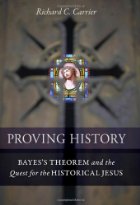 I have been studying the first half of Richard Carrier’s chapter 3, “Introducing Bayes’s Theorem”, in his recent book Proving History: Bayes’s Theorem and the Quest for the Historical Jesus. I mean studying. I want to be sure I fully understand the argument before tackling the second half of the chapter, headed Mechanics of Bayes’s Theorem, which promises to be “the most math-challenging section of the book” (p. 67). Maths is not my most outstanding strength so I want to be sure I get the basics clear before moving into those waters. I have come to a point where I can enjoy playing little mind-games with Bayes’ Theorem for the sake of reinforcing my understanding. Last night on the TV news was dramatic story of an unexpected resignation of a leading Australian political figure. So I found myself piecing all I heard, how I heard it and what I knew etc. into a Bayes’ equation and calculating the probability that the story was true. Kind of fun. At least for the moment before the novelty factor wears off.
I have been studying the first half of Richard Carrier’s chapter 3, “Introducing Bayes’s Theorem”, in his recent book Proving History: Bayes’s Theorem and the Quest for the Historical Jesus. I mean studying. I want to be sure I fully understand the argument before tackling the second half of the chapter, headed Mechanics of Bayes’s Theorem, which promises to be “the most math-challenging section of the book” (p. 67). Maths is not my most outstanding strength so I want to be sure I get the basics clear before moving into those waters. I have come to a point where I can enjoy playing little mind-games with Bayes’ Theorem for the sake of reinforcing my understanding. Last night on the TV news was dramatic story of an unexpected resignation of a leading Australian political figure. So I found myself piecing all I heard, how I heard it and what I knew etc. into a Bayes’ equation and calculating the probability that the story was true. Kind of fun. At least for the moment before the novelty factor wears off.
Result: While I believe I can see Richard’s point some of my niggling questions have not yet gone away.
When did the sun go out?
Carrier begins by setting out our reasoning when we read in the Gospels that darkness covered the whole earth for three hours at the time of the crucifixion of Jesus. What he is seeking to do is to take readers through the processes they would undergo in order to conclude that such an event almost certainly never really happened.
To make the scenario work he posits at least a barely conceivable natural cause for the event: “a vast dense cloud of space-dust swiftly drifting through the plane of the solar system . . .” — Wouldn’t the Sun’s gravity prevent that? But I’m happy to go along with the exercise for sake of argument nonetheless.
The critical point for Carrier is that what would convince us that such an event really had happened in the past is if we could find records testifying of the event across all world cultures thousands of miles apart from Britain to China.
There could not fail to have been mention or discussion of such a remarkable and terrifying event across many of these cultures among their surviving textual traditions and materials. (p. 43).
The key point is that we know in advance that this is the evidence we would expect to find IF such an event had happened.
And if indeed that were the case, we would surely have adequate warrant to believe the sun was blotted out for three hours on the corroborated day . . .
What Carrier is preparing his readers for is to accept that reasoning about historical events is fundamentally similar to reasoning in the sciences. If such and such a hypothesis (or explanation) is true then we would predict (or expect) certain events (or evidence) to be manifest.
Then there is the converse. If such a hypothesis (explanation) were true, we would NOT expect to find a universal silence in the surviving records:
[A] single claim in a single religion repeated only in its own documents (and documents relying on those), is extraordinarily improbable — unless the event was entirely made up. . . . This is a slam-dunk Argument from Silence, establishing beyond any reasonable doubt the nonhistoricity of this solar event . . . (p. 44)
My niggling question:
I follow the reasoning. But in my mind, rather than taking me into the realm of mathematics, it all leads back to my own argument about how historians know anything at all about the persons and events of the past. Continue reading “Carrier’s “Proving History”, Chapter 3(a) — Review”
